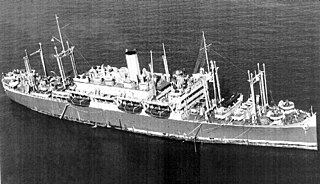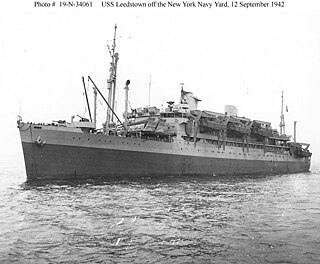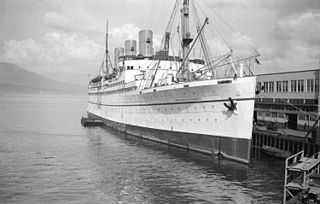
USS Refuge (AH-11), was a hospital ship of the United States Navy during World War II. The ship was built in 1921 by the New York Shipbuilding Corp., of Camden, New Jersey, as SS Blue Hen State, but was renamed President Garfield in 1923 and then SS President Madison in 1940 for service with American President Lines. Acquired by the Navy from the War Shipping Administration on 11 April 1942 the ship was commissioned as the transport USS Kenmore until conversion to a hospital ship.

USS Miantonomah (CM-10/CMc-5) was built as SS Quaker by Pusey & Jones Corporation, Wilmington, Delaware in 1938 as a commercial coastwise ship operating as a fast inland water passenger and freight carrier. Quaker was acquired by the Navy in May 1941 for conversion to a coastal minelayer. Miantonomah operated off the east coast of the United States, Africa and the Mediterranean and took part in the invasion of Europe in 1944. The ship was sunk by a mine 25 September 1944.

USS Hugh L. Scott (AP-43) was a Hugh L. Scott-class transport ship. She was built in 1921 and spent 20 years in merchant service as a passenger and cargo liner. In July 1941 the ship was delivered to the United States Department of War for Army service as the United States Army Transport Hugh L. Scott operating in the Pacific. In August 1942 the ship was transferred to the United States Navy for conversion to an attack transport, served as a troopship in Operation Torch in November 1942, and was sunk by a U-boat four days later. 59 crewmen and soldiers died during the sinking.

SS President Cleveland was originally built as Golden State for the United States Shipping Board (USSB), one of the planned World War I troop transports converted before construction into passenger and cargo vessels launched as Emergency Fleet Corporation Design 1029 ships first known, along with the smaller Design 1095 versions, in the trade as "State" ships due to names assigned for the nicknames of states and later as "535s" for their length overall. Almost all ships of both designs were renamed for United States presidents by May 1921, with Golden State being renamed President Cleveland. As one of the USSB-owned ships operated by agents of the board, President Cleveland was allocated to and operated by the Pacific Mail Steamship Company until sold by the USSB to the Dollar Steamship Line in 1925. After the demise of that line and creation of a new, replacement line, American President Lines, the ship remained with that line until government acquisition for the Second World War.

USS George F. Elliott (AP-13) was a transport acquired by the U.S. Navy during World War II. The ship was originally ordered for WW I British commercial service as War Haven and requisitioned by the United States Shipping Board (USSB) before completion as Victorious. The Navy acquired and commissioned Victorious for brief service with the Naval Overseas Transportation Service (NOTS) before return to the USSB for commercial operation both under the USSB and commercial lines, the later as City of Havre and City of Los Angeles.

USS Leedstown (AP-73), built as the Grace Line passenger and cargo ocean liner SS Santa Lucia, served as a United States Navy amphibious assault ship in World War II. The ship had first been turned over to the War Shipping Administration (WSA) and operated by Grace Line as the WSA agent from February to August 1942 in the Pacific. In August the ship, at New York, was turned over to the Navy under sub-bareboat charter from WSA. She was sunk 9 November 1942 off the Algerian coast by a German submarine after German bombers caused damage the day before.

American Legion was a United States Navy ship first launched on 11 October 1919 and decommissioned on 20 March 1946. She was built for the United States Shipping Board (USSB), one of the planned World War I troop transports converted before construction into passenger and cargo vessels, the Emergency Fleet Corporation Design 1029 ships. The ship was laid down as Koda and perhaps assigned the name Badger State at one point, but renamed American Legion before launch and one of only a few of the design not taking a state nickname. Originally operated by the USSB's agents and the Munson Steamship Line the ship saw commercial service until laid up 13 March 1939.

USS Leonard Wood (APA-12) was built by Bethlehem Shipbuilding Corporation and launched 17 September 1921 at Sparrows Point, Maryland as Nutmeg State, an Emergency Fleet Corporation Design 1029 ship intended as a World War I troop transport, but redesigned upon the armistice as a passenger and cargo ship and completed as Western World for delivery to the United States Shipping Board. The ship's acceptance on 5 May 1922 and delivery on 9 May 1922 marked the completion of the wartime shipbuilding program of the Emergency Fleet Corporation and the Shipping Board.

USS Hunter Liggett (APA-14) was built as an Emergency Fleet Corporation (EFC) Design 1029 ship. It was launched as Palmetto State, and shortly after, renamed Pan America for operation as the United States Shipping Board (USSB) owned liner operated by the Munson Steamship Line on New York to South American service. The ship was acquired by the War Department in February 1939, where it was once more renamed. The new Hunter Liggett was then ready for operation, as a United States Army transport vehicle mainly running between New York and San Francisco.

The Heywood-class attack transport was a class of US Navy attack transport built in 1918-19. Four were ordered for British use but requisitioned by the United States Shipping Board (USSB) for WW I service when the U.S. entered that war. All saw commercial service under the USSB and commercial lines until acquired by the Navy in 1940 and converted, some to transports, and eventually all into attack transports for World War II service.

RMS Empress of Canada was an ocean liner built in 1920 for the Canadian Pacific Steamships (CP) by Fairfield Shipbuilding & Engineering Company at Govan on the Clyde in Scotland. This ship—the first of three CP vessels to be named Empress of Canada—regularly traversed the trans-Pacific route between the west coast of Canada and the Asian waters until 1939.

SS Manchuria was a passenger and cargo liner launched 1903 for the San Francisco-trans Pacific service of the Pacific Mail Steamship Company. During World War I the ship was commissioned 25 April 1918–11 September 1919 for United States Navy service as USS Manchuria (ID-1633). After return to civilian service the ship was acquired by the Dollar Steamship Line in 1928 until that line suffered financial difficulties in 1938 and ownership of Manchuria was taken over by the United States Maritime Commission which chartered the ship to American President Lines which operated her as President Johnson. During World War II she operated as a War Shipping Administration transport with American President Lines its agent allocated to United States Army requirements. After World War II, she was returned to American President Lines, sold and renamed Santa Cruz. The liner was scrapped in Italy in 1952.

SS Point Bonita was constructed in 1918 and launched 27 March 1918 after a hull being built for foreign owners at Albina Engine and Machine Works was requisitioned during World War I by the United States Shipping Board (USSB). The ship saw service as the Navy transport USS Point Bonita, assigned Identification Number 3496, from 7 October 1918 to 7 April 1919, was returned to the USSB and saw civilian service with several commercial companies as San Pedro and Oliver Olson before again seeing service in World War II as USS Camanga (AG-42). After return to commercial service as Oliver Olson the ship was wrecked at the entrance to Bandon harbor in Oregon.

USS Besboro (AG-66) was built as Caddopeak, a United States Shipping Board (USSB) Emergency Fleet Corporation Design 1049 cargo ship built by Albina Engine & Machine Works, launched 18 October 1918. From 1922 Caddopeak served several commercial shipping companies until sold in 1937 to Burns Steamship Company and renamed Lurline Burns. On 2 February 1942 the ship was delivered to the War Shipping Administration, allocated to the United States Army and operated by Burns and Alaska Steamship Company under an Army charter agreement.

SS Maui was built as a commercial passenger ship in 1916 for the Matson Navigation Company of San Francisco and served between the United States West Coast and Hawaii until acquired for World War I service by the United States Navy on 6 March 1918. The ship was commissioned USS Maui (ID-1514) serving as a troop transport from 1918 to 1919. The ship was returned to Matson for commercial service September 1919 and continued in commercial service until purchased by the United States Army in December 1941. USAT Maui was laid up by the Army in 1946 and scrapped in 1948.

President Taylor was a cargo-liner, ex President Polk, ex Granite State, requisitioned for war service in December 1941 and allocated by the War Shipping Administration (WSA) to the U.S. Army and operating as a troopship in the Pacific Ocean in World War II when grounded and eventually lost on 14 February 1942.

USAHS Marigold was a United States Army hospital ship during World War II. The ship was built as Old North State in 1920 for the United States Shipping Board as a civilian passenger/cargo liner. The ship changed ownership and operating companies several times with name changes to President Van Buren and President Fillmore before being acquired for military transport service in 1941. After government acquisition during World War II President Fillmore served as a War Shipping Administration troop transport before conversion to hospital ship service.

SS President Taft was launched as one of the "state" ships, Buckeye State, completed by the United States Shipping Board as cargo passenger ships after originally being laid down as troop transports. Buckeye State had been laid down as Bertrice but was converted and renamed before launching. Originally assigned to the Matson Navigation Company as the Shipping Board's agent, the ship was later renamed President Taft and assigned to Pacific Mail Steamship Company for operation. In 1925 the Shipping Board sold the ship to Dollar Steamship Company. President Taft was operated by Dollar and then its successor American President Lines until requisitioned by the War Department on 17 June 1941.
The Design 1095 ship was an Emergency Fleet Corporation (EFC) design for a troop transport to be built at New York Shipbuilding Corporation and delivered to the United States Shipping Board (USSB) that, at the end of World War I hostilities, was modified to a combined passenger and cargo vessel. The contract was for thirteen ships, EFC hulls 2579 though 2591, but later adjusted to seven ships with the remainder being changed during construction to the slightly larger ships of EFC Design 1029 built from the start as passenger and cargo ships rather than being modified from the troop ship plan.

SS Admiral Halstead was a merchant ship built in 1920 by the Submarine Boat Corporation, Newark, New Jersey, and operating originally as Suwordenco. The ship's history illustrates the state of the industry as the massive World War I shipbuilding program transitioned to an effort to sell and operate hulls in a market glutted by wartime shipbuilding. By the outbreak of World War II Suwordenco was one of the few ships operating as its owners went bankrupt. The ship was bought for operation from the Puget Sound to California ports until it was caught up in the prelude to the United States' entry into the war.




















